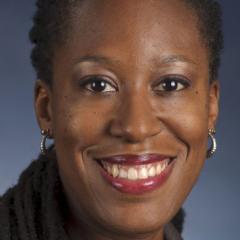Christina H. Fuller: Air quality and communities in Atlanta
Dr. Christina H. Fuller is an assistant professor in the Division of Environmental Health at Georgia State University’s School of Public Health where she works in the field of air quality exposure assessment and environmental epidemiology. Her research interests include outdoor air pollution, the effects of air pollution on respiratory and cardiovascular health, community-engaged research, urban health and environmental justice.
One recent project, the results of which were published in February 2017 in the International Journal of Environmental Research and Public Health (open access), looked at how an existing stand of trees at a middle school near Atlanta impacted pollution exposure during three seasons. She worked with the organization Mothers & Others for Clean Air, a program of the American Lung Association of the Southeast, to conduct monitoring work and was also able to teach the students about air pollution.
What she found was that installation of vegetative barriers shows potential as a method to reduce near-road concentrations of particles. Because traffic-related air pollution is a persistent concern especially in urban areas where populations live in close proximity to roadways innovative solutions are needed to minimize human exposure. Her findings are particularly exciting from an environmental justice perspective, she says, because there is a history of major roads being built through disadvantaged communities and communities of color, and with them comes higher concentrations of pollution.
Finding that tree barriers help reduce some kinds of traffic pollution has implications for existing facilities, but also should be taken into consideration when siting new schools, daycares and housing. Instead of building in a way that requires clearcutting existing trees, there could be better resident health outcomes associated with leaving some trees in place.
Fuller says that her involvement with the projects was spurred by the community’s request for her scientific expertise. She says she tries to be mindful of some key factors in academic/community partnership like this one:
- With environmental justice and community projects, there is typically a historical imbalance of power to consider. Researchers in the past have come in and recruited people to do a study and then left without providing any benefit to the community. It is important to know your role as a researcher and decide ahead of time with the community partner how you are going to work together for mutual benefit.
- Since research takes so long, it is important to have intermediate goals that are shared with the community partner. This can take different forms, such as an education component to give people information about the topic after data collection but before the long process of academic publication is complete. Having regular meetings that ensure an open line of communication is also critical.
- There are varying levels of involvement when researchers are working with communities and doing partnerships. At one end of the spectrum you can have a full-fledged community-based participatory research project, while at the other end you might do the research independently and share the final results with community stakeholders. Being clear and intentional at the start of the project is key to managing expectations.
